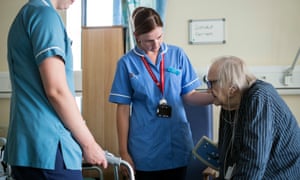A novel told from the point of view of a teenage girl with autism, written by schoolgirls with autism, has been published after the students – frustrated by their experience of a world that rejects and ignores them – decided to take matters into their own hands.
The pupils at Limpsfield Grange school, the country’s only state-funded residential school for girls with special needs, mined their own most painful – and uplifting – experiences to write M in the Middle, a young adult novel created with the help of their creative writing teacher, Vicky Martin.
“If society just realised the very simple fact that girls can have autism as well as boys, then the life of girls with autism would instantly be so much better because we wouldn’t be so scared of being labelled as weird, abnormal and strange,” said Francesca Warren, 14, one of the 70 girls at the school.
“Because people think autism is something only boys have – and because girls with autism behave completely differently to boys – girls have to constantly mask their condition,” Warren added. “But having to pretend to be someone else is debilitating and humiliating. And it doesn’t even work: people can get annoyed with you even when you mask [because they sense your inauthenticity].”
Warren sits with her friends in the office of Sarah Wild, the headteacher at Limpsfield Grange. Fizzing with as many different opinions as any other group of teenage girls, they only speak with one voice when it comes to the question of whether boys with autism have an easier life.
“Yes. Yes. Yes!” they shout in passionate union. “Ding. Ding!” whooped one girl, for added emphasis.
The hilarity quickly ebbed away. “I’m prey in a world of predators,” said 12-year-old Lauren Mittelmeier, quietly. “Life is really hard for girls with autism. Why is life so difficult?”
The struggle to get their condition recognised is just the start of the battle for girls with autism. Even when girls are diagnosed, their life doesn’t necessarily get any easier: there is virtually no specialist support, academic or otherwise, for girls.
Mittelmeier’s parents moved home from Dorset so their daughter could attend Limpsfield Grange school, in Oxted, Surrey. This is not unusual: another family moved from Cornwall. One other girl boards during the week and travels the 250 miles back to her home every weekend.
Mittelmeier said: “I was diagnosed at eight but my autism wasn’t acknowledged by my school. They just thought I was an idiot. They were trained to work with autistic people but I’m guessing it was boys they were trained for, not girls.”
There is no official data on autism diagnoses, although the National Autistic Society (NAS) is calling for local authorities to start collecting it, as well as ending the “autism diagnosis crisis” that sees children waiting for nine years and more for a diagnosis.
Statistics appear to show that more men and boys than women and girls have a diagnosis of autism. The study most quoted, written by Leo Kanner in 1943, found there were four times as many boys as girls. In later years, various studies, together with anecdotal evidence, put the men to women ratio at anything from 2:1 to 16:1.
But Sarah Wild, head of Limpsfield Grange, believes there are just as many girls with autism as there are boys.
She said: “I genuinely think there are equal numbers but the stereotype that it’s a male condition is self-perpetuating: the diagnostic checklists and tests have been developed for boys and men, while girls and women present completely differently.”
According to the NAS 2012 survey of 8,000 people with autism, just 8% of girls with Asperger syndrome were diagnosed before six years old, compared to 25% of boys. Only 21% of girls with Asperger’s were diagnosed by the age of 11, compared to 52% of boys. Many adult women who took part in the survey didn’t have a diagnosis at all: 10% compared to 5% of males.
An added problem facing girls and women with autism is that if their true condition isn’t identified, they are at risk of being misdiagnosed, said Wild. “If, for example, a clinician asks a girl with autism if she ‘hears voices’ or ‘sees people’, she’ll say ‘Yes’ because she’s being entirely literal – and then she’ll be misdiagnosed with schizophrenia or another mental health disorders,” she said.
The NAS survey suggests that 42% of females have been misdiagnosed, compared with 30% of males. Many women remain undiagnosed well into late adulthood until they self-diagnose: females in the NAS survey were more likely to have paid for their diagnosis (14% of females, compared with 9% of males).
Misdiagnosis and no diagnosis, as well as a lack of support, understanding and recognition once a correct diagnosis has been made, leave girls and women in a dangerous space. According to the NAS survey, 38% of females with Asperger’s have another serious mental health condition, including eating disorders and depression.
But momentum for change is starting to gather pace: in January, the National Association of Headteachers is holding a girls on the autism spectrum conference to prepare a call for action on the issue.
Before that, on 8 November, there is a private House of Lords roundtable organised by the autism and girls forum – itself set up just 18 months ago.
“We set up the forum because there is so much energy coming forward now from parents, academics, children and young people’s mental health services (Camhs), and teachers, that we’re missing identifying this group of girls,” said Professor Barry Carpenter, chair of the forum.
“The pattern we’re seeing is that these girls come badly unstuck in their teenage years. They manage to mask it when they’re younger, which means when they crumble, they don’t have any coping strategies and structures to fall back on for support,” he said.
The House of Lords roundtable has a quest, said Carpenter: “We need to engage political will, without which nothing will change. There needs to be a systematic review, either under the women and equalities committee or we need to set up a new, cross-governmental task force.
“We need to harness all this evidence coming to us and marshall it to incentivise more research, more help for schools and Camhs.
“We have a very vulnerable group of girls here,” he said. “I can’t personally live with the fact we’re not doing nearly enough to help them.”
M in the Middle is published by Jessica Kingsley Publications (£8.99). Click here to buy a copy for £7.37
Schoolgirls with autism share experiences in young adult novel












